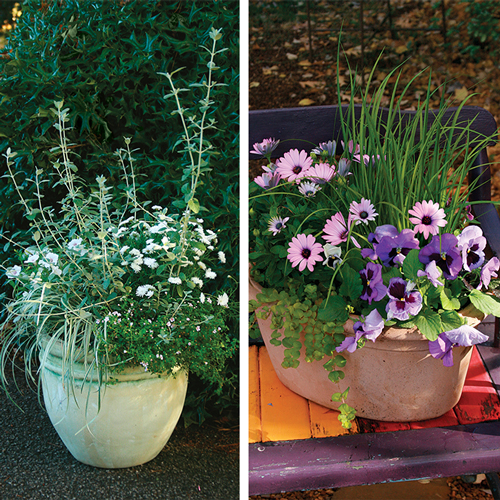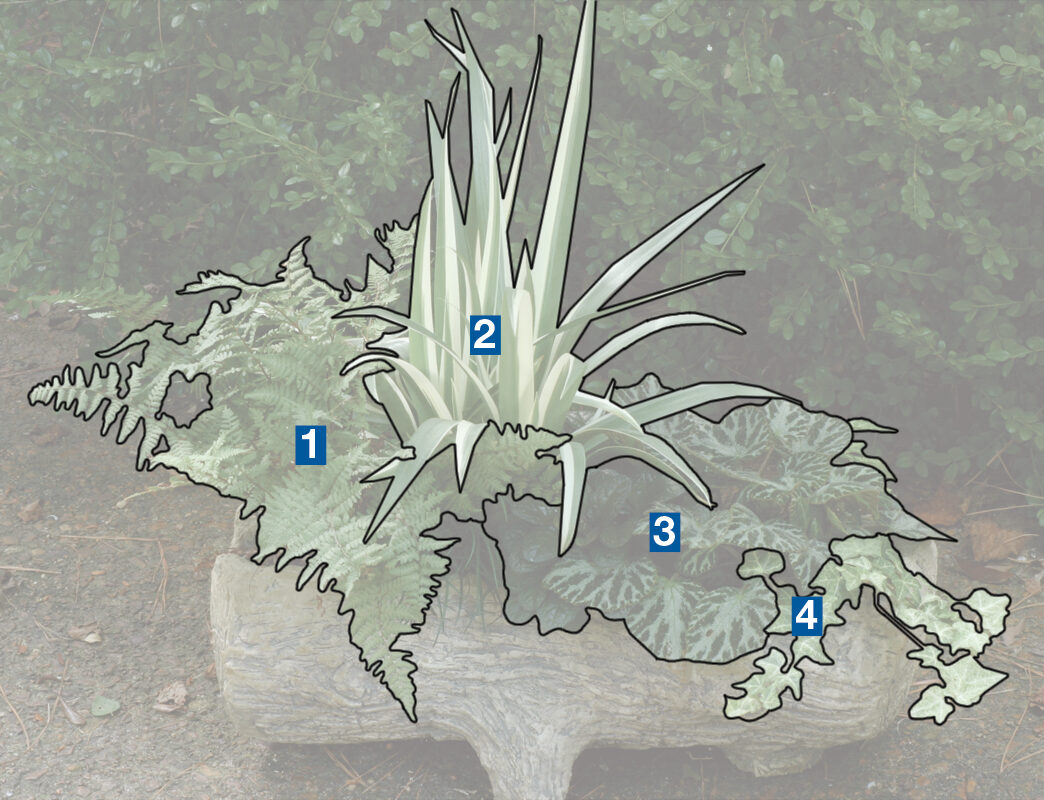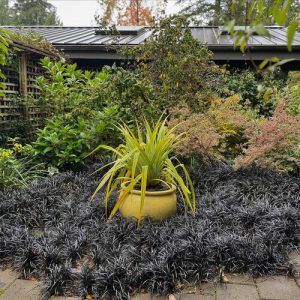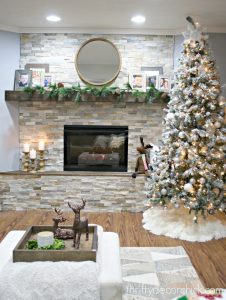
Spring is the start of it all—the time when everything you have dreamed about since last year becomes possible. These possibilities come alive with your first plant picks of the season. Reliable, hardy foliage, rather than delicate, fickle flowers, has always been my first choice when creating a container arrangement. Another factor I consider when choosing plants is finding the right ones for the right situations; no plant will thrive in unsatisfactory conditions.
With these basic ideas in mind, you can start your spring-container combinations in a variety of ways, but two approaches seem the easiest to me. You can shop for plants and then go find a suitable container, or you can have a gorgeous container and then go look for the perfect plants to go in it. Whichever way you choose to start, picking plants and containers that inspire you is a sure way to create something fabulous.
Fragrant flowers sweeten the pot
You can never go wrong with fragrance. A pot of cyclamen and nemesia always draws my friends and visitors over to take a sniff. These plants love and appreciate the cool spring weather. Adding evergreen corkscrew rush creates a linear form with year-round appeal—just change up its partners. In the summer months, corkscrew rush mixes well with low-growing annuals of all kinds, like dwarf lantana and alternanthera.
- ‘Quartz Creek’ corkscrew rush (Juncus effusus ‘Quartz Creek’, USDA Hardiness Zones 4–9)
- Cyclamen (Cyclamen persicum cv., annual)
- Compact Innocence® nemesia (Nemesia fruticans ‘Tiktoc’, annual)
- Variegated English ivy (Hedera helix* cv., Zones 5–11)
Jazz up the usual suspects

Three or four plants are all it takes to make a great combo. In this combination, the colorful, cool pastel mounds of pansy and African daisy are separated and enlivened with spiky sweet flag. ‘Goldilocks’ creeping Jenny adds a final touch of bright color spilling over the container’s rim. Using the classic rule of three—a thriller, a filler, and a spiller—is still the safest and most popular recipe for successful mixes.
- Soprano® Purple African daisy (Osteospermum ‘Osoutis’, annual)
- Pansy (Viola × wittrockiana cv., Zones 8–11)
- ‘Ogon’ Japanese sweet flag (Acorus gramineus ‘Ogon’, Zones 6–9)
- ‘Goldilocks’ creeping Jenny (Lysimachia nummularia* ‘Goldilocks’, Zones 4–8)
A unique pot inspires a creative theme

Specialized pots create an opportunity for unique combos. Some of the newest and most popular containers available are made to look aged and are often molded into the unique shape of tree trunks, logs, and branches. I filled this faux-bois (false-wood) container with iris, fern, and begonia to keep with that natural, woodsy feel. Unique containers like this don’t need a lot of fussy plants. The simplest approach is sometimes the most effective.
- ‘Lady in Red’ fern (Athyrium filix-femina ‘Lady in Red’, Zones 4–9)
- Variegated roof iris (Iris tectorum ‘Variegata’, Zones 5–9)
- ‘Silver Jewel’ begonia (Begonia ‘Silver Jewel’, Zones 9–11)
- ‘Fantasia’ variegated English ivy (Hedera helix* ‘Fantasia’, Zones 5–11)
Containers can be focal points

The container came first in this combo. I chose the unusually tall, thin form of variegated boxwood to set off the slender shape of the pot, while the color scheme was designed to enhance the beautiful patina of the container. I don’t recommend covering up attractive or decorative containers with a lot of pendulous plants—or else you’ll never see the pot. You can add one or two trailers for extra eye appeal, if you can keep them under control and clip them back from time to time.
- Sundew Springs™ lysimachia (Lysimachia Sundew Springs™, annual)
- ‘Chapel Hill Gold’ lantana (Lantana camara* ‘Chapel Hill Gold’, Zone 11)
- Variegated boxwood (Buxus sempervirens ‘Variegata’, Zones 6–8)
- ‘Silvery Sun-proof’ liriope (Liriope muscari ‘Silvery Sunproof’, Zones 6–10)
One person’s junk is another person’s treasure

Almost anything can be a container, with antiques, junk, and handmade objects being used to hold plant treasures. My old, crumbly birdbath doesn’t hold water very well anymore, so I decided to showcase some large succulents in it. I thought that if I planned for light and dark colors, soft and rough textures, and short and tall specimens, I could create a lovely scene and show off my old antique at the same time.
- Sedum (Sedum cv., Zones 6–11)
- Ghost plant (Graptopetalum paraguayense, Zone 11)
- Hens and chicks (Sempervivum sp., Zones 4–11)
- ‘Ogon’ sedum (Sedum makinoi ‘Ogon’, Zones 6–9)
- Variegated mini jade plant (Portulacaria afra ‘Variegata’, Zones 10–11)
Add life with bold colors

When I put my first flowering containers together for the season, I want them to stand out. I like to use colors that grab me and say, ‘Hey, take a look!’ The fleshy ‘Red Flash’ caladium is the perfect plant to start with, followed by some colorful impatiens and plectranthus for a little chartreuse touch around the bottom; the lime green color makes all other colors seem more vibrant.
- ‘Red Flash’ caladium (Caladium bicolor ‘Red Flash’, Zones 10–11)
- ‘Rita’s Gold’ Boston fern (Nephrolepis exaltata ‘Rita’s Gold’, Zones 10–11)
- ‘Troy’s Gold’ plectranthus (Plectranthus ciliatus ‘Troy’s Gold’, Zones 10–11)
- Dazzler™ Mix impatiens (Impatiens walleriana Dazzler™ Mix, annual)
Recycled foliage does the job

Don’t trash all of your plants during fall cleanup. Foliage that can hang on throughout the year should be overwintered so that you can recycle it in spring. The glistening silvery foliage of this evergreen bush germander and ‘Silvery Sunproof’ liriope have been saved from last fall, but you wouldn’t know it by looking at them. You can jazz up a foliage planting with cold-hardy flowering annuals, like petunia and marguerite daisy, which easily tuck in between persistent perennials.
- Bush germander (Teucrium fruticans, Zones 8–9)
- Supertunia® Vista Silverberry petunia (Petunia ‘USTUNI60-01M’, annual)
- Cabana® Trailing Blue bacopa (Sutera cordata ‘Sutcatrabl’, annual)
- Molimba® Mini Double White marguerite daisy (Argyranthemum frutescens ‘Argymidowi’, annual)
- ‘Silvery Sunproof’ liriope (Liriope muscari ‘Silvery Sunproof’, Zones 6–10)
Bowls are remarkably versatile

Low bowls work anywhere that their full lushness can be appreciated—especially when used as tabletop centerpieces. Calm-colored flowers mingled with soft, mounding foliage create a beautiful place for your eyes to rest. The key here is to avoid plants or containers that could obstruct your view; after all, not all containers have to be big and tall.
- Compact Innocence® nemesia (Nemesia fruticans ‘Tiktoc’, annual)
- ‘Evergold’ sedge (Carex oshimensis ‘Evergold’, Zones 6–9)
- Irish moss (Sagina subulata, Zones 4–7)
- Wire vine (Muehlenbeckia axillaris, Zones 8–10)
- Violas (Viola cvs., Zones 7–10)
- ‘Black Scallop’ ajuga (Ajuga reptans* ‘Black Scallop’, Zones 3–9)
- ‘Icicles’ licorice plant (Helichrysum thianschanicum ‘Icicles’, Zones 10–11)
- ‘Citronelle’ heuchera (Heuchera villosa ‘Citronelle’, Zones 4–9)
Waterwise plants make great combos

Ornamental pineapple is a favorite of mine because of its striking color, its dramatic stature, and its easy nature. It requires the same well-drained soil as succulents, so you can leave it alone when you go on trips and it will still be alive when you get back. This combo mixes curving lines with bold spikes and cool blues with neon greens, and lets the ornamental pineapple create a dark, bold, central statement.
- Ornamental pineapple (Ananas sp., Zones 10–11)
- Ghost plant (Graptopetalum paraguayense, Zone 11)
- ‘Black Gem’ aloe (Aloe ‘Black Gem’, Zones 10–11)
- Senecio (Senecio sp., Zones 9–11)
- ‘Ogon’ sedum (Sedum makinoi ‘Ogon’, Zones 6–9)
- ‘Golden Girl’ panda plant (Kalanchoe tomentosa ‘Golden Girl’, Zone 11)
- Pencil tree (Euphorbia tirucalli, Zone 11)
- Variegated mini jade plant (Portulacaria afra ‘Variegata’, Zones 10–11)
Fresh start, fresh techniques
I’ve been hungry for spring all winter long. Now that the ground is beginning to warm, I can’t wait any longer to get my hands dirty. I start off my routine with recycled greenery, like a few mature plants that I’ve safely harbored indoors over the winter and evergreen perennials that I always keep around outdoors. I then scramble over to my collection of empty pots to start matching them up. By adding in a few annuals, I have full containers in no time. Here are some techniques to get your containers off to a healthy start.
Make plants thrive in the right potting mix
A high-quality potting medium is of the utmost importance if you want your plants to do more than merely survive, but it’s seldom found for sale in just one bag. I routinely use several products in my potting media. The major ingredients are a bark-based mix, a little peat moss, coir (coconut fibers), and compost. I add sand and perlite to increase air circulation and drainage. Depending on what I’m planting, I usually finish off by adding an organic fertilizer to my containers. Here is my basic recipe:
- 1 part bark-based mix
- 1 part peat moss
- 1 part compost
- 1 part perlite
- 1 part sand
Try gravel for great drainage and a perfect finishing touch

It’s common for most gardeners to grab a few stones or pieces of broken clay pots to cover the hole in the bottom of a container. I add a little gravel or broken pottery over the hole just so that it doesn’t get clogged with dirt and leave my plants’ roots swimming in stale water. If I am growing succulents, I also add gravel to the potting soil for even better drainage. I then top-dress the container with a little more gravel, using blue-gray or warm, earth tone–colored stones. This not only is attractive but also keeps water and soil from splashing onto my plants. This final benefit is especially important if you are growing succulents.The last thing you want to do is use more water to wash dirt off their leaves.
Fill the void in large pots to save on soil

Oversize or extraheavy containers can be soil hogs, but you can save on potting mix and give your back a reprieve by finding the perfect-size, lightweight plastic pot to fit into your jumbo pot (photo right). If you’re potting up a container where the sidewalls taper uniformly, you can often save on soil volume and spare the extra plastic pot by lifting up the floor of your decorative container with a false bottom made expressly for this purpose (photo below); one such planter insert is Ups-A-Daisy (ups-a-daisy.com). This product still allows proper drainage for your plants, can be kept year after year, and is available at most garden centers. It doesn’t fit straight-sided pots, however, so you might need to fill the void in those containers with plastic jugs.

Design Tips

Use containers to brighten outdoor tabletops
The plants in a tabletop container should have the same effect as an interesting conversationalist: captivating but not obtrusive. Otherwise, the container runs the risk of being removed from the table.
Selecting plants for a tabletop container can be frustrating: If, for example, the plants grow too tall, the container often has to be set to one side as people sit down to talk. Dwarf or slow-growing plants are, therefore, the way to go. Containers can be small, alpine-looking troughs or naturalistic combinations. Some arrangements can be more formal depending on the choice of flowers and the container. The options are endless, but done right, these tabletop designs will always draw admiring looks—even from the designer.

Use your design instinct to pair spring plants
Choosing the right plants to go together is a lot like shopping for a scarf to go with a blouse and jacket, or looking for a tie to match to a shirt. If the colors blend and the textures complement one another, then you know when it’s right. If the combo screams “No,” then put a plant back and try something else. If you don’t think your instinct is on par, mimic color combos you see other gardeners pulling off.
*These plants are considered invasive in some areas. Please check invasiveplantatlas.org or your state’s list of invasive plants for more information.














